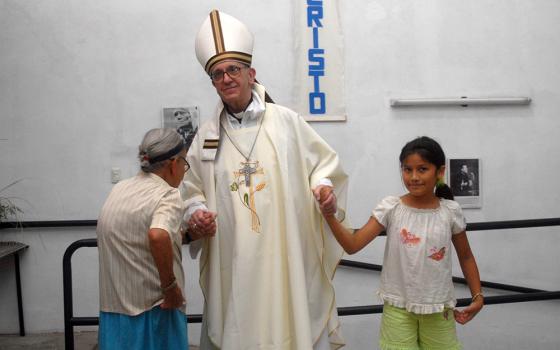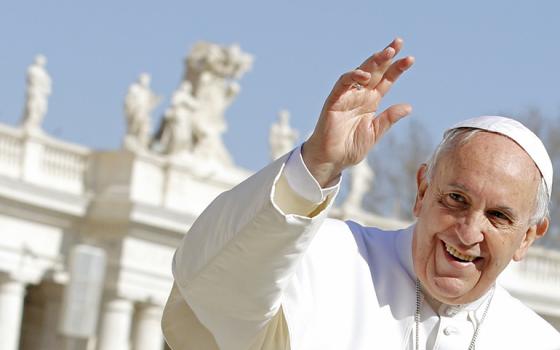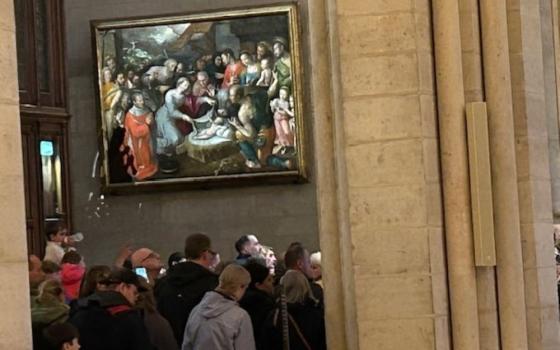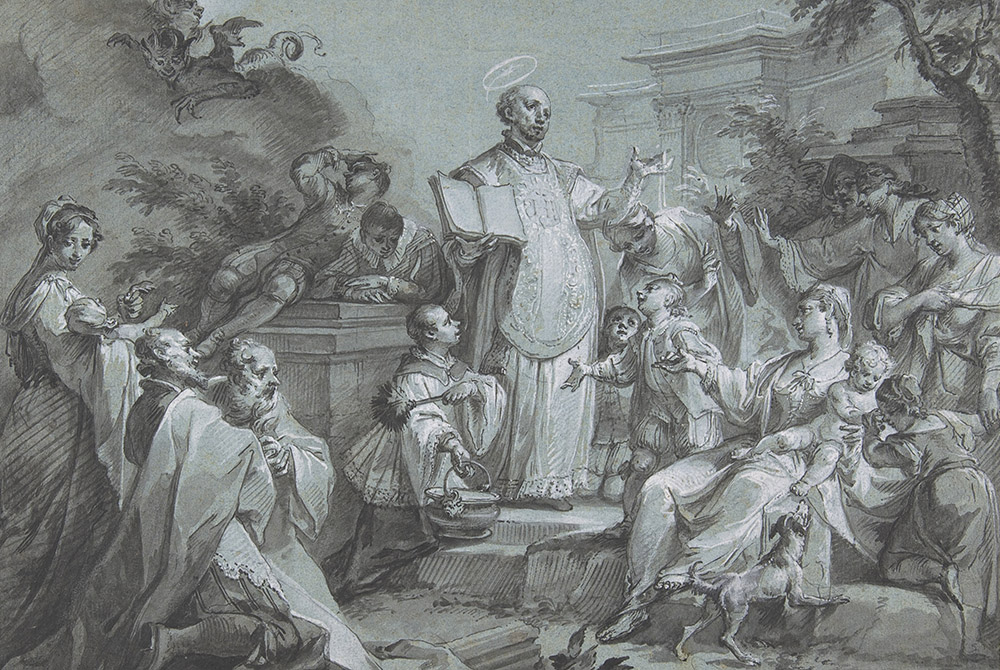
"Saint Ignatius of Loyola Preaching," by Johann Wolfgang Baumgartner, a drawing in ink dated before 1761 (Metropolitan Museum of Art)
At first glance, the 1609 engraving seems straightforward enough: A teacher stands at an elevated lectern at the front of a classroom. Three benches in front of long tables crammed with about 15 young male students form a u-shape in front of him. The kids look squirmy and distracted. Some have books open; most do not.
But look a little closer and it's clear that one of these students doesn't fit in. There's a man in his early 30s seated at the near end of the bench on the right. His hands are spread and he has the rapt attention of a pupil sitting near him. He does not seem to be paying attention to the teacher, maybe lost in thought. There's a halo around his head.
Beneath the image, there is a caption in Latin: "In Barcelona, at the age of thirty-three, so that he may train himself for the saving of souls, he applies himself to learn the first elements of Grammar but is taken out of himself and distracted by the Devil who tries in vain to call his soul away from his studies by delightful but irrelevant insights regarding heavenly things."
The "he" here is Iñigo Lopez de Oñaz y Loyola, or, as he's known today, St. Ignatius Loyola, whose feast day is tomorrow. Despite all the great things Ignatius did, like writing the Spiritual Exercises and founding the Society of Jesus, I just can't stop thinking about this scene of him as a student, sitting in a classroom with children two decades his junior, distracted by the devil.
Ignatius spent two years in this grammar school classroom, studying Latin with Master Jeronimo Ardevol. Three years earlier, while serving as a soldier, a cannonball had shattered his leg at the Battle of Pamplona. He experienced a life-changing religious conversion during his long convalescence, a spark of zeal that led to the first drafting of the Spiritual Exercises and a subsequent decision to sail to the Holy Land, where he could live out his days working to convert non-Christians to the faith.
According to the biography by Jesuit Fr. George Traub and Debra Mooney, Ignatius had only been in the Holy Land for a few weeks when church authorities told him to go back to Europe. Chastened, Ignatius decided he needed a more formal education before he could "help souls." In order to enroll at a university, though, he first needed to learn some basics. Without something like a GED option for later-in-life learners in those days, that meant grammar school.
His decision to go through with it — and not just for a semester or two — is a vivid illustration of Ignatius' humility.
I wonder what went through Ignatius' head on his first day in that classroom. Did he feel silly or embarrassed? Or was he so sure of the path God was calling him to take that he sat alongside the children without thinking twice?
I know how I would've felt in that situation: Just fine, because I would have left right away and gone for a hike or taken a nap. No way I'm humiliating myself like that. If Ignatius was like me, he would've quit right then and probably faded into obscurity. His decision to go through with it — and not just for a semester or two — is a vivid illustration of Ignatius' humility.
Humility is a virtue that's not always well understood. It's often used to mean self-effacing ("saying you're not much of a bridge player when you know perfectly well you are," in the words of theologian Frederick Buechner) or "talented but also quiet or shy." A humble person can be those things, but they're not synonymous with humility.
Ignatius certainly wasn't a shrinking violet. His own version of humility reminds me of a quote from Dag Hammarskjöld's spiritual classic, Markings: "Humility is just as much the opposite of self-abasement as it is of self-exaltation. To be humble is not to make comparisons," he writes. "Secure in its reality, the self is neither better nor worse, bigger nor smaller, than anything else in the universe."
Ignatius in the classroom at Barcelona didn't trouble himself with comparisons; he didn't look around the room, see the kids goofing off and say, "No way, I can't be here with them." He felt secure in his call to do something big for Christ and he would do whatever it took to follow that call. His humility allowed him to see himself clearly, as a gifted child of God with a lot to offer, who also had plenty to learn before he could live out his mission.
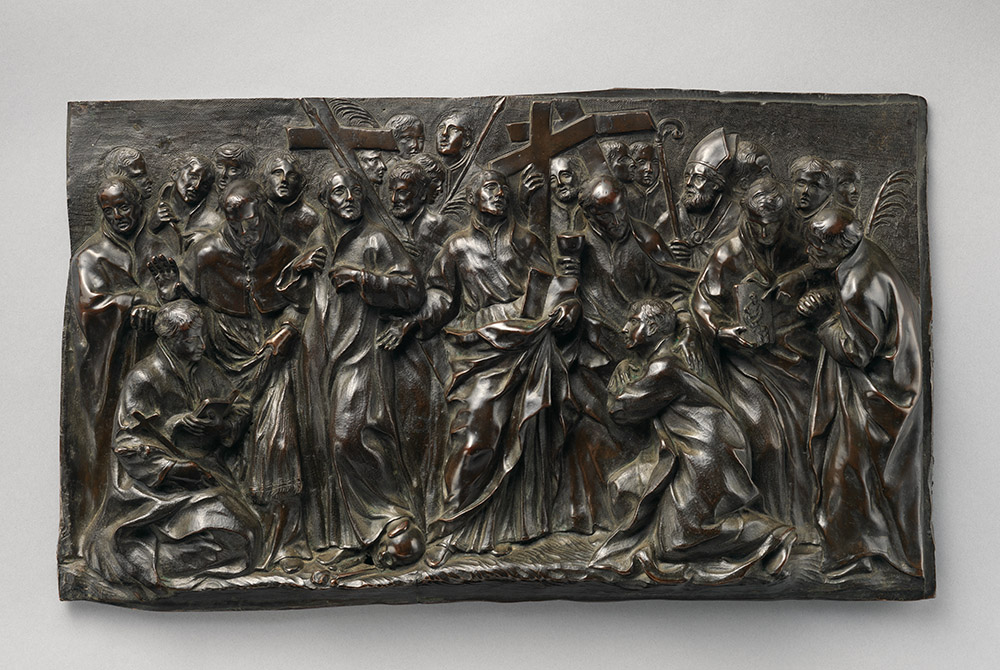
"Saint Ignatius Loyola with Saints and Martyrs of the Jesuit Order," a 17th-century bronze sculpture by Alessandro Algardi; This is a variant of the relief on the reliquary urn of St. Ignatius on that saint's altar in the church of the Gesù, Rome. The urn was cast in 1629. (Metropolitan Museum of Art)
Agreeing to learn alongside children is not the only element of Ignatius' humility in this story. I'm also moved by the way he decided to start over after facing discouragement in the Holy Land. He had felt fired up and ready to go until the Franciscans there said, "Not so fast." Ignatius admitted he was wrong and that he had to backtrack and change course slightly.
His path is a great model for all of us today, especially those entrusted with leadership of some kind. Try something bold and new, mess up an attempt, admit your mistake, stay committed to your dream even though it could be tempting to quit at this point, take a step backward to learn more, and try something bold again — this time, informed by your experience.
This feast of St. Ignatius, I'm praying for more Ignatian-style humility in my family and work life — not a downplaying of my gifts, but openness to admitting my faults and a refusal to let potential embarrassment stop me from learning something new and trying again.
[Mike Jordan Laskey is senior communications manager for the Jesuit Conference in Washington, D.C. He is the author of The Ministry of Peace and Justice (Liturgical Press) and lives with his family in Maryland.]
Editor's note: We can send you a newsletter every time a Young Voices column is posted to NCRonline.org. Go to this page to sign up.
Advertisement

